Related Research Articles

Asti is a comune (municipality) of 74,348 inhabitants (1–1–2021) located in the Italian region of Piedmont, about 55 kilometres east of Turin, in the plain of the Tanaro River. It is the capital of the province of Asti and it is deemed to be the modern capital of Montferrat.
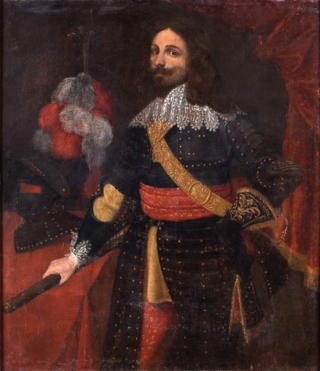
Thomas Francis of Savoy, 1st Prince of Carignano was an Italian military commander and the founder of the Carignano branch of the House of Savoy, which reigned as kings of Piedmont-Sardinia from 1831 to 1861, and as kings of Italy from 1861 until the dynasty's deposition in 1946.

Manfred was the last King of Sicily from the Hohenstaufen dynasty, reigning from 1258 until his death. The natural son of the Holy Roman Emperor Frederick II, Manfred became regent over the kingdom of Sicily on behalf of his nephew Conradin in 1254. As regent he subdued rebellions in the kingdom, until in 1258 he usurped Conradin's rule. After an initial attempt to appease Pope Innocent IV he took up the ongoing conflict between the Hohenstaufens and the papacy through combat and political alliances. He defeated the papal army at Foggia on 2 December 1254. Excommunicated by three successive popes, Manfred was the target of a Crusade (1255–66) called first by Pope Alexander IV and then by Urban IV. Nothing came of Alexander's call, but Urban enlisted the aid of Charles of Anjou in overthrowing Manfred. Manfred was killed during his defeat by Charles at the Battle of Benevento, and Charles assumed kingship of Sicily.

The Duchy of Milan was a state in Northern Italy, created in 1395 by Gian Galeazzo Visconti, then the lord of Milan, and a member of the important Visconti family, which had been ruling the city since 1277.
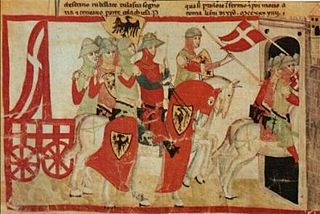
The Battle of Cortenuova was fought on 27 November 1237 in the course of the Guelphs and Ghibellines Wars: in it, Holy Roman Emperor Frederick II defeated the Second Lombard League.

Mondovì is a town and comune (township) in Piedmont, northern Italy, about 80 kilometres (50 mi) from Turin. The area around it is known as the Monregalese.

The First Italian War, or Charles VIII's Italian War, was the opening phase of the Italian Wars. The war pitted Charles VIII of France, who had initial Milanese aid, against the Holy Roman Empire, Spain and an alliance of Italian powers led by Pope Alexander VI, known as the League of Venice.
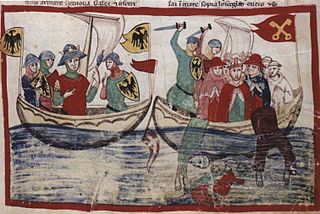
The naval Battle of Giglio was a military clash between a fleet of the Holy Roman Emperor Frederick II and a fleet of the Republic of Genoa in the Tyrrhenian Sea. It took place on Friday, May 3, 1241 between the islands of Montecristo and Giglio in the Tuscan Archipelago and ended with the victory of the Imperial fleet.

The Battle on the Po was a battle of the Wars in Lombardy. It occurred in June 1431, on the Po River, near Cremona. The battle was fought between 85 Venetian galleys, sent towards Cremona to support Count of Carmagnola's army, and a somewhat superior number of Milanese galleys. The Venetians were commanded by Niccolò Trevisani.
John II Palaeologus was the Margrave of Montferrat from 1338.

The Battle of Gamenario, fought on 22 April 1345, was a decisive battle of the wars between the Guelphs and Ghibellines. It took place in north-west Italy in what is now part of the commune of Santena about 15 km southeast of Turin.
William VII, called the Great Marquis, was the twelfth Marquis of Montferrat from 1253 to his death. He was also the titular King of Thessalonica.
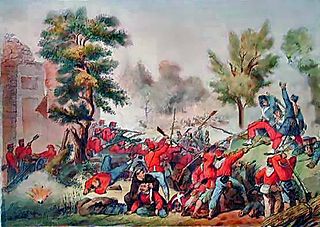
The Battle of the Volturno refers to a series of military clashes between Giuseppe Garibaldi's volunteers and the troops of the Kingdom of Two Sicilies occurring around the River Volturno, between the cities of Capua and Caserta in northern Campania, in September and October 1860. The main battle took place on 1 October 1860 between 30,000 Garibaldines and 25,000 Bourbon troops (Neapolitans).

The Turco, Turchi, Turci or sometimes Turco dei De Castello family's rise to prominence originated in 12th-century Asti, Italy, and later the surrounding comunes of Frinco, Mombercelli, Montemagno, Tonco, Viale, and in part Barbaresco, Neive, Revigliasco d'Asti and Savigliano. They are considered one of the "Casane Astigiane", the major familial banking "houses" that powered the economy of medioeval Asti.
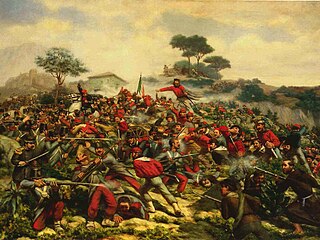
The Battle of Calatafimi was fought on the 15 May 1860 between Giuseppe Garibaldi's Redshirts and the troops of the Kingdom of the Two Sicilies at Calatafimi, Sicily, as part of the Expedition of the Thousand. The battle was the first of Garibaldi's victory during his invasion of Sicily in 1860 and saw his 'Thousand' defeat a larger Neapolitan army sent from Palermo to block the roads to the Sicilian capital.

The Marquisate of Incisa was a lordship of the House of Aleramici in southern Piedmont, northern Italy, which existed between the 12th and 16th centuries.

Some events which occurred in 1345 in Italy:
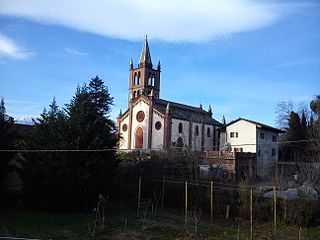
The Battle of Montebruno took place between the Guelph City of Asti and the Ghibelline County of Savoy. Thomas II of Savoy invaded the territory of Asti, but he was defeated by the Astigiani army at Montebruno in Garzigliana, near Pinerolo. Thomas II had taken refuge in Turin, however there he was captured.

The Battle of Cassano was fought in the Autumn of 1259 between Guelph and Ghibelline armies in Northern Italy.
The Battle of Motta was fought in late August 1412 when an invading army of Hungarians, Germans and Croats led by Pippo Spano and Voivode Miklós Marczali attacked the Venetian positions at Motta in Italy and suffered a heavy defeat.
References
- 1 2 Kleinherz, Christopher (2004). Medieval Italy: an encyclopedia, Volume 1. New York and London.
{{cite book}}: CS1 maint: location missing publisher (link) - 1 2 3 Gallenga, Antonio Carlo Napoleone (1855). History of Piedmont, Volume 2. London.
{{cite book}}: CS1 maint: location missing publisher (link) - 1 2 Bury, John Bagnell (1967). The Cambridge medieval history, Volume 6. Cambridge.
{{cite book}}: CS1 maint: location missing publisher (link) - ↑ Runciman, Steven (1958). The Sicilian Vespers . Cambridge University Press.
{{cite book}}: CS1 maint: location missing publisher (link)